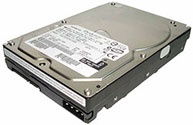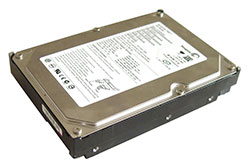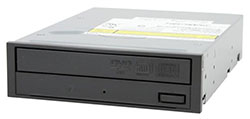Buyer's Guide: Mid-Range to High-End, May 2005
by Jarred Walton on May 23, 2005 5:30 PM EST- Posted in
- Guides
Storage Recommendations
There hasn't been a whole lot of change in the storage segment in terms of new products. Prices have dropped, but the recommendations overall remain about the same. Our recent Price Guide covered the storage market in more detail, and we'll refer interested readers there. The basic summary is that the HDD scene has not changed too much, and the DVDR scene has changed even less. The good news is that it means it's less difficult to pick a good product, which is especially true of DVDRs. The bad news is that I/O intensive tasks will still be waiting on the drives as much as ever.A topic that also deserves mention in regards to hard drives is RAID (Redundant Array of Inexpensive Disks). RAID can allow for either increased transfer rates, improved reliability, or both. RAID 0 provides increased performance by reading and writing to multiple drives at the same time in a process called striping, effectively doubling the sustained transfer rate for two drives. The problem is that if any drive in a RAID 0 configuration fails, you lose all the data. That's definitely not something to take lightly. RAID 1 goes the other route and provides a 1 for 1 copy of everything written to the hard drives, a.k.a. mirroring. In the event of a drive failure, the faulty drive is deactivated and you run with one drive until a replacement can be found. The drawback is that you now pay twice as much per GB of available storage. RAID 1+0 (sometimes called RAID 10) combines both striping and mirroring, but it requires at least four drives for the standard setup and you still only get half the realizable storage. RAID 5 is the most common remaining option, requiring a minimum of three drives to function. Only one of the drives in the array becomes "lost" capacity, but you need a good (re: expensive) controller to get acceptable RAID 5 performance. We don't really feel that RAID is something most people need, and a good backup strategy - to CDs or DVDs, usually - is often just as important as redundancy. Still, the option is there for those who need it.
Mid-Range HDD Recommendation
Hard Drive: Seagate 250GB 7200.8 SATA
Price: $128 Shipped
Picking a good hard drive for the Mid-Range market is relatively easy. You want a low cost per GB, and for the most part, the different brands all perform at close to the same level. Provided that you get a hard drive that has Fluid Dynamic Bearings (FDB), you shouldn't have to worry about any high pitched whine emanating from your computer. (This was a problem in the past, particularly with Western Digital and Maxtor drives.) Unless you're trying to build a truly silent PC, the amount of noise generated by the heads moving around will normally be drowned out by the noise of the GPU, CPU, and case fans - even the noisiest of drives is difficult to hear when confined within an ATX case. Just to make this clear, we mean that seek noise is difficult to hear, not bearing noise; we have numerous older drives that emit a high-pitched whine that can be heard a couple of rooms away.
Our recommendation goes to the Seagate model for several reasons. Besides being spacious and quiet, it provides NCQ support and a 5-year warranty, all at a price that's just as low as any of the competition. If you are for some reason opposed to 250GB hard drives, you can find everything from 80GB to 200GB at a lower price than the Seagate 250GB (depending on model and brand). The smaller drives end up coming with a higher cost per GB, however, to the point where anything less than 80GB isn't worth considering. $60 for an 80GB drive is still a reasonable deal, but you can double the capacity for only a 50% price increase. Other than Seagate, we like Samsung drives due to their even lower noise levels. Hitachi, Maxtor, and Western Digital are all decent as well, but we would suggest that you make sure you get FDB with the Maxtor and WD drives. SATA-2 drives are also starting to show up at retail, and while they may not offer a performance advantage, the price difference is negligible. Hitachi is the only manufacturer currently showing up in our Pricing Engine, although that will change with time.
 |
 |
 |
| Click images to enlarge. | ||
High-End HDD Recommendations
Hard Drive: Western Digital Raptor 74GB 10,000RPM SATA
Price: $180 Shipped
Hard Drive: Maxtor DiamondMax 10 250GB 16MB SATA
Price: $160 Shipped
Hard Drive: Hitachi 7K250 400GB SATA
Price: $265 Shipped
There are three areas that we consider to be high end for hard drives. First is the option for a faster spindle speed, leading to faster transfer rates and access times. 10,000RPM SATA and SCSI drives are available, but the SATA drives are cheaper and don't require an additional SCSI controller. You can even go for a 15,000RPM SCSI drive, although the cost is twice as much (or more) as that of the 10,000RPM drives of the same capacity. The next item that makes a hard drive high end is additional cache, and at present, the only manufacturer to fill that niche is Maxtor, with both its SATA and PATA MaxLine III/DiamondMax 10 models including 16MB of cache rather than 8MB. The final item that can make a high end drive is increased capacity, with 300 to 400 GB drives now available. Increased capacity via higher data densities also improves the transfer rate of a drive, although it doesn't help the access times. Determining which of these features are the most important along with keeping price in check is difficult. Sure, you can get 146GB 15,000RPM SCSI drives to satisfy the need for performance and capacity, but at a cost of over $1000 per drive, they're not meant for mere mortals.
In the end, we can't really give one specific recommendation for a high end drive. If you need capacity above all else, the Hitachi 7K250 400GB will fit the bill. Seagate also offers a 400GB 7200.8 drive for about $25 more if you're interested. Striking a middle ground between performance and capacity is the Maxtor DiamondMax 10 line, of which we've selected the 250GB model. The 300GB model has a similar cost per GB, so if you want a bit more capacity, that's definitely an option. While we don't care too much for the old IDE interface, we should also note that the Maxtor drives are available in PATA format for quite a bit less. Finally, if you're only interested in having the highest possible sustained transfer rate and access times, the Western Digital Raptor 74GB gets our recommendation again. 15,000RPM SCSI drives would be even faster than the Raptor, but they start at around $400 for the Hitachi 15K73 and go up from there - twice as much as the Raptor, not counting the cost of SCSI controllers and cables.
Optical Recommendation
DVD+R Drive: NEC 16X 3520A
Price: $48 Shipped
With 16X burn speeds for both DVD+R and DVD-R media and 8X/6X for the respective RW variants, the only thing really missing from the NEC 3520A is DVD-RAM support. If you need or want that, the LG GSA-4163B has 5X DVD-RAM support for just a few dollars more. Either drive will work well for most people, and while some will argue that Plextor or Sony drives are better, we haven't been able to back up such claims with any tests. Given the higher price - over twice as much in the case of the Plextor 16X - we cannot justify such a purchase. Pioneer's DVR-109 is another alternative, and Lite-On, Toshiba, and BenQ are also worth considering, assuming that the price is right. We feel that features and performance are all now close enough that we'd simply take the cheapest 16X DVDR Dual-Layer capable drive and be done with it, which is why the NEC and LG get our recommendation. As always, match the color of the drive with your case if that's important to you.
Floppy Recommendation
Floppy: Any
Price: $8 Shipped
When you're spending this much money on a nice, new system, it's almost a shame to have to put in old technology like a floppy drive. While not strictly required, we'd rather have the drive installed and never use it than to not have it and discover later that we need it. Anyone planning on using RAID will definitely want a floppy drive, as it's required for installing XP onto any RAID setup that we're aware of. Windows Longhorn should finally kill off the floppy requirement, but that's still more than a year off. $8 over 365 days amounts to just 2.2 cents per day - you can manage it, right? As with the DVDR drive, you will probably want to match the floppy to the case.












60 Comments
View All Comments
PotterVilla - Wednesday, December 28, 2005 - link
Hello,I've not been able to find a XFX, MSI, or eVGA 6800GT graphics card at new egg (I'm not really looking to buy, just being wishful) and I also saw that the 6800XT is only $170. The 7800GT is more in your ballpark of $345 a card. Would ether of these cards be an upgrade, and has their price gone down that much ($175) in only about seven months?
Thank you.
jonp - Friday, August 26, 2005 - link
i wonder about the hp 1905fp recommend for the mid-range non-gaming display. there are considerable comments here and elsewhere about the poor analog (d-sub 15 pin) performance ie image quality. the Genesis gm-5321 controller chip is no longer shown on their web site and the datasheets are no longer available as well. (one wonders how much longer the 1905fp will even be available?) the dvi interface might be great, but there are some of us who connect their display through a kvm that only handles analog signals--so dvi performance is of little interest. i think we need a new monitor review and new pick for the non-gaming monitor recommendation. we depend on Anandtech for solid testing and non-subjective analysis to guide us in our quest for the best value. it is clear that we need new help in this area.JarredWalton - Thursday, June 16, 2005 - link
56 - not usually on NVIDIA nF3/4 or Intel chipsets. That's only an issue with secondary SATA controllers (VIA, SiS, Silicon Image, etc.) But still, never hurts to have that $8 part around just in case!mhallang - Wednesday, June 15, 2005 - link
Another reason to get a floppy drive is to install Win XP on a SATA drive. Maybe SP2 is different, and I would bet there's another way around it; but my experience was that I needed a floppy with the SATA drivers during the install process for XP.JarredWalton - Monday, June 13, 2005 - link
54 - Oh, I'd stay far away from XP64 for SLI. Raw doesn't begin to describe it, IMO. Longhorn is when I'll actually consider switching to a 64-bit OS.GreedyBumps - Thursday, June 9, 2005 - link
I built this system with all major components that are in this guide and cannot get SLI to work. Both cards work great individually but when I try to but them both in in SLI mode screen goes black after the black windows loading screen. I have tried all the driver / bios updates for everything I could find and still no dice.One issue could be that I installed Windows x64 professional - maybe some drivers are still too raw.
Also - the SLI jumpers on this DFI Lanparty board are a complete pain. They are tough to pull out and there are 6 of them. When you are trying to get SLI to work it is absolute nightmare to keep switching between SLI and Normal jumper cable settings.
JarredWalton - Wednesday, June 1, 2005 - link
52 - I got the information from Wesley. Basically, there is a higher number of RMA for motherboards and RAM when voltages above 3.3V are used. (Not too surprising, really, as higher V = higher heat.) 3.3V and below are fine, but there is a jumper to allow up to 4.0V. If you use that jumper, it causes problems. That's my understanding. In other words, don't plan on running OCZ VX at 3.7V with no active cooling. :)hgkfahgsa - Wednesday, June 1, 2005 - link
Jarred, could you elaborate on the problems with high voltages with the DFI cards? Is there any chance of the problems being resolved, does 3.3 volts work? etc... Thanks.JarredWalton - Friday, May 27, 2005 - link
50 - I know there are some Turtle Beach cards with S/PDIF in and out connections. M-Audio also has some, i.e. the Delta and Audiophile. Which one you want depends on the use. Most only have optical *OR* coaxial (RCA). I think many of the models with external boxes have both. If you were interested in an expensive, "everything" solution, there's the Audigy 4 Pro, but that's $280 or so, and I can't vouch for the actual quality as a whole.Honestly, I'm not a demanding audio person. If you want more advice on audio, I'm sure there are people in our forums that can provide better advice for "pro level" cards. You may as well ask me for advice on cars while you're at it! (Get something cheap and reliable!) ;-)
devslash - Friday, May 27, 2005 - link
how important is capability of S/PDIF input. i dont see many motherboards that have this on-board.isn't it important/good to have it, so DVD's audio
can be directly fed into the on-board sound system?
can you recommend a good board w/ S/PDIF input?